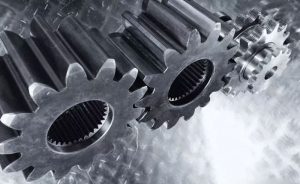What is carburized steel?
The steel used to make carburized parts is referred as carburized carbon steel. Carburizing is the heat treatment process of quenching after carburizing atoms to the surface of steel parts. Carbon infiltration can significantly improve the wear resistance, durability, toughness and other properties of steel parts.
Carburized carbon steel is generally after carburizing and then quenching and tempering at low temperature, then the heart of the part is the low carbon Martensite with sufficient strength and toughness, the surface is hard and wear-resisting tempered Martensite and a certain amount of fine carbide structure. Some structural parts work under strong impact and wear conditions, such as transmission gears on automobiles and tractors, cams and piston pins on internal combustion engines, etc, which need high surface hardness and wear resistance, while the core requirements have higher strength and toughness, appropriate at this time of low carbon steel by carburizing and quenching and low temperature tempering, the center of the parts is low carbon steel quenching organization, to ensure the high toughness and sufficient strength, while the surface (at a certain depth) with high carbon content (0.85% ~ 1.05%), the high hardness after quenching (HRC>60) and good wear resistance.
 The Chemistry of Carburized steel
The Chemistry of Carburized steel
Carburized carbon steel is generally low carbon steel (carbon content 0.15% ~ 0.25%), so that the carburized parts of the heart has good toughness and plasticity.
In order to improve the strength of the steel core, a certain number of alloying elements can be added to the steel, such as Cr, Ni, Mn, Mo, W, Ti, B, etc. The Cr, Mn, Ni and other alloying increase the hardenability of steel, so that its surface layer and heart structure can be strengthened after quenching and tempering at low temperature, In addition, a small amount of Mo, W, Ti and other carbides can form stable alloy carbides, which refine grain and inhibit overheating of steel parts during carburizing. A small amount of B(0.001% ~ 0.004%) can strongly increase the hardenability of alloyed carbon steels.
Classification of carburized carbon steels
Alloy-carburized carbon steels are classified like this according to their hardenability or strength:
Carburizing steel with low hardenability
That’s low strength carburized carbon steel (Tensile strength ≤800MPa), such as 1018, 1056 etc. These steels have low hardenability, low core strength after carburizing, quenching and low-temperature tempering, as well as poor strength and toughness, mainly used for manufacturing, wear-resistant parts with low stress and low strength requirements, such as camshaft of diesel engine, piston pin, slide block, pinion and so on. The core grains of such steels tend to grow when carburized, especially for manganese steels. If high performance is needed, the second quenching can be done after carburizing, that is, after carburizing, the first normalizing treatment to eliminate the overheated structure formed by carburizing and then reheating and quenching.
Carburizing steel with medium hardenability
That’s medium strength carburized carbon steel (Tensile strength =800 ~ 1200MPa), such as SAE 4120, 4140etc. They have about 4% of alloying elements, mainly Cr and Mn, effectively improve hardenability and mechanical properties (tensile strength =1000 ~ 1200MPa), used to manufacture heavy load of medium and small wear pieces and medium load of gear with large modulus. Such as automobile, tractor gearbox and rear axle gear, gear shaft, cross pin head, spline shaft sleeve, valve seat, CAM disk, etc. Because it also contains Ti, V and Mo, the growth tendency of austenite grains is small during carburizing, and the carburizing temperature can be pre-cooled to about 870°C for direct quenching, and after tempering at low temperature, the parts have better mechanical properties.
Carburizing steel with high hardenability
Namely high strength carburized carbon steel (tensile strength > 1200MPa), such as SAE 8620 and , 8720, 9310 etc. The hardenability of steel, especially Ni, can be greatly improved with more Cr than 7.5% in total alloying element, so as to improve its strength and good toughness.
These steels can be used as important large parts for heavy loads and heavy wear, such as active traction gears for diesel locomotives, crankshafts for diesel engines, connecting rods and precision bolts for cylinder heads.
The higher alloying element makes the C-curve move to the right and obtains the Martensite structure even the air cooling. The Martensite transition temperature also drops sharply, so that the carburizing surface layer will retain a large number of residual Austenite after quenching. In order to reduce the residual Austenite volume after quenching, the carbide can be spheroidized or cold treated before quenching by tempering at high temperatures.






